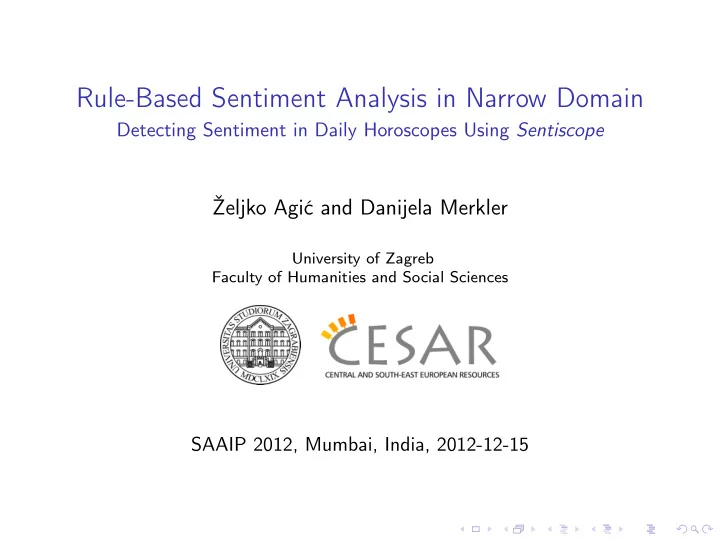

Rule-Based Sentiment Analysis in Narrow Domain Detecting Sentiment in Daily Horoscopes Using Sentiscope Željko Agić and Danijela Merkler University of Zagreb Faculty of Humanities and Social Sciences SAAIP 2012, Mumbai, India, 2012-12-15
Overview ◮ motivation ◮ system design and implementation 1. collecting horoscope texts from the web on a daily basis 2. rule-based module for polarity phrase detection designed in NooJ linguistic development environment 3. web-based wrapper application for counting polarity phrases and assigning overall sentiment scores 4. simple visualization module ◮ evaluation ◮ rule-based component demo and visualization demo
Document collection ◮ developed a simple focused crawler ◮ collected horoscopes from largest websites (in Croatian) ◮ selected by Google search index ◮ eight different newspaper portals and specialized portals ◮ collected from 2012-02-11 to 2012-05-10 ◮ 7,716 articles, 484,179 tokens
Inter-annotator agreement ◮ development set of 333 articles manually annotated by two human annotators for overall sentiment and polarity phrases ◮ lineary weighted kappa: 0.593 → moderate agreement ◮ excluding neutral sentiment, kappa: 0.989 → very good agreement + – x Σ + 94 0 26 120 – 1 82 31 114 x 18 4 77 99 113 86 134 333 Σ
Overall article sentiment and polarity phrases ◮ positive phrases imply positive overall sentiment and vice versa ◮ also applies when both types of phrases are present ◮ even distribution of phrases for neutral sentiment articles ◮ justifies theoretical baseline that overall sentiment is assigned from the polarity group with the highest count <p> <n> both <p> in both <n> in both + 410 27 23 85 27 – 19 321 15 19 53 x 142 145 67 117 115
Phrase detection ◮ designed in two stages — from scratch and by observing the development set ◮ grouped in two NooJ local grammars ◮ positive and negative sentiment detection ◮ focus on three POS ◮ adjectives, nouns and verbs ◮ adverbs are homographic with adjectives in singular nominative case in neuter gender ◮ 170 negative and 139 positive words and phrases ◮ aggregate of positive and negative words which occur with a negation, which results in expressing the opposite sentiment ◮ 33 negated positive and 17 negated negative words and phrases ◮ a total of 203 words and phrases for negative and 156 words and phrases for positive sentiment detection
Demo Polarity phrase detection in NooJ
Evaluation ◮ conducted on a manually annotated held-out test set ◮ initial run also on portion of development set ◮ approximately 11,500 tokens in 168 articles each ◮ polarity phrase detection accuracy of the rule-based component sample precision recall F 1 -score initial 0.371 0.283 0.321 development 0.435 0.469 0.451 test 0.413 0.393 0.402
Evaluation ◮ system accuracy on overall sentiment detection and confusion matrix for overall sentiment assignment ◮ system performance is high in discriminating between positive and negative overall sentiment ◮ accuracy steeply decreases upon inclusion of neutral sentiment ◮ positive words and phrases are more accurately detected + ∗ – ∗ x ∗ precision recall F 1 -score + 40 3 17 0.677 0.666 0.671 – 2 25 17 0.555 0.568 0.561 x 17 17 30 0.468 0.468 0.468
Demo Prototype web interface for data visualization
Conclusions and future work ◮ detecting sentiment in narrow domain such as daily horoscope texts is not easy to achieve ◮ complex phrases and syntax ◮ specific style, even for each individual author ◮ obtained results as baseline for further work ◮ overall F 1 -score: 0.566 ◮ F 1 -score for phrase detection: 0.402 ◮ moderate inter-annotator agreement ◮ obtained data can be used for different types of linguistic analysis ◮ re-implementation of the link between polarity phrases and overall sentiment ◮ elimination of neutral sentiment category ◮ model adjustment and application for sentiment annotation and visualization in other domains ◮ precision and recall shown to be much higher (0.9, 0.6) using the same framework for financial texts
Thank you for your attention! �
Recommend
More recommend